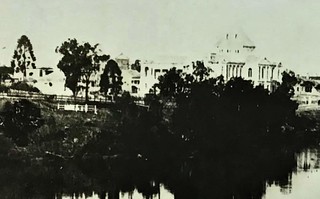Next to the hospital were the hospital and the soldiers gardens. However, it looks like that at least some children were buried here as well, perhaps in the hospital garden along the river? Approximately where the current Turbot street ends at North Quay.
For a long time the burial site of three children from the military remained a visible remnant of the the original burial ground, In 1881 at least three burials were exhumed from the cemetery and removed with their monuments to the Toowong Cemetery. These were all the remains of children who had died at the convict settlement. They were William Roberts, 5 years 2 months old son of Charles Roberts of the Commissariat Department who died in 1831, Peter Macauley, 15 years and 8 months old son of Private Peter Macauley of the 17th Regiment of Foot who died in 1832, and Jane Pittard the 12 month old daughter of Colour Sergeant John Pittard of the 57th Regiment of Foot who died in 1833.
Mortally rates were high – 50% among children – because of the many tropic diseases and a lack of hygiene as the water supply was often polluted. Between 1825 and 1843 265 people died in Brisbane and they were buried either is in the convict – cemetery, the majority – 220 – being convicts or in the site described below.


The official cemetery was situated at the bend of the river, on the (present day) northern approach to the William Jolly Bridge, bounded by Skew Street, Saul Street, Eagle Terrace and Upper Roma Street. Past the old kiln.
With the many deaths in the settlement the Reverend John Vincent reported in 1829 that the cemetery was too small and that the ground was very hard to dig in. It could take two men 6 to 7 hours to dig a grave. It was hard to call these plots a proper cemetery.In the running up to the opening of the free settlement the cemetery was extended in 1839, With a growing township the cemeteries became overcrowded and with residential and business areas building up around it, that situation became untenable and burials were stopped in 1843.
The old burial ground remained Crown land. Rather rapidly it fell into disrepair and over the following decades monuments disappeared, fences were broken and cattle were using it as grazing grounds. In 1851 it was decided to put an iron bark fence around it.
It finally was redeveloped in 1875 and a small park is the last reminder of the site with the plaque in the picture below (click to enlarge the picture). Some of the graves from the Old Burial Ground (as it became known) were relocated to the new site. According to Tom Petrie, some of the cedar planks from the coffins ended up as building material in Fortitude Valley.
In September 1843 a new multi-denominational cemetery was opened, known as the Northern Brisbane Burial Grounds, also known as the Paddington/Milton cemetery.
However, rather unceremoniously parts of this cemetery became developed and slab-huts and later houses were just build over it by newly arriving immigrants. Up to 10,000 people may have been buried here. During that period the cemetery flooded at several occasions. After 1875, the burial ground was closed and new burials were to take place in the newly established Toowong Cemetery. The site itself fell into a state of disrepair, headstones were sold off at auction and one of the Ithaca councillors suggested rather unceremonious to use them as road metal. In the end only 150 gravesites were exhumed and moved to Toowong Cemetery. In 1914 the site became a recreation park, the Lang Park. the site was used as a rubbish tip, a night soil tip, a circus venue, a military base, an athletic track until in the 1950s it became the home of the Brisbane Rugby League.
